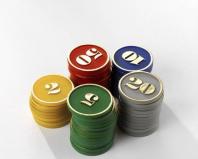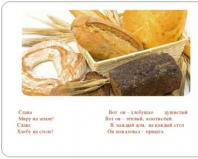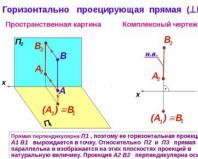How bread comes to us presentation. How the bread came to the table
1 slide

2 slide
Glory Here it is - a fragrant bread for Peace on earth! Here it is - warm, golden. Glory To every home, to every table, to Bread on the table! He came - he came.

3 slide
In it is our health, strength, in it is wonderful warmth. How many hands raised Him, protected Him, took care of Him! This is exactly what the story begins about.

4 slide
The story begins... Winter evening, Finest hour. The fields shine under the moon, The earth, the nurse, sleeps. The white-winged blizzards sang a lullaby to her and covered her with a downy snow blanket.

5 slide
The earth is sleeping... And what is it dreaming of? Dreaming of ripe wheat. Well, people have no time for sleep: Come soon, spring!

6 slide
Why are you knocking, Masters, Golden hands? We repair, we repair Tractors! - We sharpen, we sharpen the plows! -Agronomist in a white robe, what is he doing? -It's an important matter! I'm checking the seeds. Come soon, spring! Come soon, spring! From beyond the mountains, from beyond the seas!

7 slide
The story continues. Spring is upon us. The sun shone brightly, the streams flowed, bubbling, and, throwing back the blanket, the earth was washed.

8 slide
You have rested, dear fellow, - Isn’t it time to work?.. The agronomist said: - It’s time! Start the tractor! Tractors go out into the steppe, pulling plows on a trailer. Cut, plows, like a knife, Juicy, Fat black soil! With a fine comb, harrow. Comb the land! Let's prepare a soft bed for the grain.

Slide 9
The story continues. You can sow, Good luck! An old sower sowed from a basket-sieve. Today the seeder-machine is busy with this task. Digs furrows quickly, lays grains in them. You, seed-grain, will lie down in the furrow at the bottom. Don’t be afraid, golden one, it’s not a big deal that it’s dark there! To the light, to the sun, quickly send a sprout from the earth!

10 slide
The story continues. Our friendly shoots came out to the sun from the darkness. “Hello, sun, it’s us!”

11 slide
The story continues. The wheat has grown. Let it pour now, get stronger, and spike! Yes, this summer is dry. Like a stove, the earth is heated. The plants want to drink. “Drink!..” - They rustle sadly.

12 slide
The wheat is asking us to drink, Okay, let's give you a drink: Let's put water on the fields, Drink, nurse-earth. Drink, roots, stems, young spikelets. Young, and mustachioed, and already rich in grain!

Slide 13
The story continues. Our harvest is ripe. The free wind blows in the field, Waves, waves walk in the field: What is not the sea - The expanse of fields?! Only there are no ships.

Slide 14
But look closely into the endless expanse: What is there, in the distance?.. Harvesters float out into the steppe, Like ships at sea.

15 slide
Oh, what a machine! Well, combine operator, show me how sharp knives move when cutting wheat. Like a grain being knocked out of a tight ear. How - please, it’s ready! - It pours into the box.

16 slide
Introduce the guys to the combine, Let us touch the levers, Let us press the signal, So that the driver can pick up the grain.

Slide 17
Now the driver heard it, rushing, now it’s buzzing: “I’m coming!.. I’m coming!..” Leisya, warm wheat. Straight to the back On the move.

18 slide
The drivers don't go to bed: -We'll get some sleep afterwards!.. Hitch the second trailer! Help out the people's bread! Headlights shine along the roads and probe the way. Who is this, rushing and riding? Bread is coming, not just anyone!
Topic: How did the bread come to the table? Goal: To study where finished bread comes from. The object of study is bread. The subject of the study is methods of bread production. Hypothesis: 1) suppose, having studied the history and basic concepts of bread, the author will be able to compare, in the course of the research, the methods and methods of producing bread in the old days and at the present time. 2) If the author gets acquainted with the main stages of growing and preparing bread, and also finds out what ingredients are needed for production, then we will find out how bread appears on our table. Objectives: find out the history of the appearance of bread; get acquainted with the main stages of cultivation, procurement and production of bread and bakery products; find out how many and what ingredients are needed to prepare 1 loaf. Research methods: 1. Study of historical literature, concepts of cereals, bread using encyclopedias and the Internet. 2. Observe how they sow, grow, and harvest grain in the fields of the Sorochelogovsky state farm in the Pervomaisky district of the Altai Territory. 3. Find out the process of turning grain into flour. 4. Get acquainted with the process of making bakery products at the Novoaltaysky bakery. 5.Bake bread at home. 6.Study fiction.

Bread was discovered over 15 thousand years ago. The name of the bread was given by ancient Greek bakers. They baked bread in clay forms - pots called "klibanos". It was from this name that the word “bread” appeared, which was borrowed by other peoples in different versions: the ancient Goths called bread “hlaifs”, from which the word “hlaib” was formed in the old German language, which was then transformed into the Russian “bread”. Model of grain harvesting in the old days

Map-scheme of the appearance of bread Plow the ground in the fall for planting winter rye Sow rye seeds Protect and protect seedlings Harvesting bread with combines Grain is dried, cleaned, partly to warehouses, partly to the elevator of the state farm Grain receiving enterprise in Novoaltaysk Mill Warehouses Novoaltaysk bakery Shops of the city and region

Experience. Baking a loaf. To knead the dough we needed: 1 kg of wheat flour, 50 g of fresh yeast, 250 g of butter, 1 glass of sugar, 0.5 liters of milk, 2 eggs, a pinch of salt and 1 egg for decoration. After kneading the dough, we put it in a warm place for 2 hours so that it rises. Knead the dough several times to make the loaf more airy. Then, we laid out the dough on the table and tore off a small piece for decoration. A ball was made from the main piece and placed on a greased baking sheet. Decorations were made from the remaining dough: swans, spikelets, flowers. Brush the loaf with beaten egg and place decorations on it. Placed in the oven at t˚˚ to bake. Our loaf was baked in 40 minutes. While the bread was baking there was such an aroma! People say: “if the house smells of bread, all misfortunes leave the house.”


Bread as a national symbol In honor of bread, hymns and songs were composed, and holidays were held to mark the end of the harvest. The bride and groom were greeted with bread and salt, a newborn, and dear guests were welcomed. They made up proverbs and sayings: “Bread is the head of everything,” “Bread on the table, so is the table, but not a piece of bread, so is the table,” “No bread, no dinner.” In Greece there is a belief that a person who eats food without bread will be punished by the gods. In Rus' they believe that if the house smells of freshly baked bread, then all evil spirits disappear. Many poems and riddles have been written in honor of bread. Paintings have been painted.

Conclusion In my work, I talked about the path bread takes before reaching our table. I learned about the history of bread. Experimentally, I found out how much flour is needed to bake a loaf and determined the amount of time spent. To more clearly study the path from grain to loaf, I made a diagram. Conducted a survey of classmates on the topic. For a more interesting presentation of information, the results of the study were presented in the form of a presentation, which also included photographs, a booklet of recipes, a crossword puzzle, a collection of materials about bread, as well as a model of harvesting bread in the old days.

Municipal preschool educational institution
"Kindergarten No. 35"
Final lesson
“Where did the bread on the table come from?”
Prepared by:
Seversk - 2016
Program content: Introduce children to the work of grain growers. To reinforce children's knowledge that bread is a valuable food product that people cannot live without. Activate the words in speech: grain grower, combine, seeder, bakery, mill, elevator, spring. To instill in children respect for bread and the work of the people who grow it. Develop fine motor skills, creativity and the ability to realize your own artistic vision.
Preliminary work: Reading followed by discussion: M. Prishvin “Fox Bread”, V. Palchinskaite “Bread”, J. Vanag “Bread Earned with Your Own Hands”, V. Krupin “Father’s Field”. Learning proverbs and sayings about bread and labor.
Equipment: a loaf of bread, an embroidered towel, ears of wheat, rye, barley, a “wonderful bag”, a series of pictures “How the bread came to the table.” For: aprons, hats, flour, yeast dough, baking sheet.
Educator: Guys, guess the riddle
Guess easily and quickly:
Soft, lush and fragrant,
He's black, he's white,
And sometimes it’s burnt.
Children: Bread.
Educator: Today in class you will learn where the bread that we buy every day in the store comes from, you will get acquainted with the work of the people who grow it.
I have a “Wonderful bag”, you will find out what is in it by guessing the riddle:
He is golden and mustachioed,
There are a hundred guys in a hundred pockets.
Children: Spikelet.
The teacher takes out ears of wheat, barley, and rye from the “Wonderful Bag”.
Guys, you guessed the riddle correctly. These are spikelets of various grain crops (look at the spikelets, learn to distinguish them from each other).
Educator: Guys, tell me what it’s called
Ear of wheat -...
What is the name of the ear of rye -...
What is the name of an ear of barley -...
(children answer: wheat ear, rye ear, barley ear).
Educator:
Now look at these spikelets and tell me what they have in common, what are they made of? (children's answers)
What does the proverb “Grain to grain - there will be a bag” mean?
(children's answers).
Educator: Plants that produce grain are called grain plants; the main food product of people, bread, is prepared from them.
Look at these pictures, they will help us get acquainted with the hard work of grain growers. This is the name given to people who grow grain crops.
Consideration of a series of plot paintings followed by discussion.
What time of year is shown in the first picture? (The picture shows spring).
Where does the tractor work? (The tractor is working in the field).
What is the name of the profession of a person who works on a tractor? (The profession of a person who works on a tractor is called a tractor driver).
What work does a tractor do? (The tractor plows the ground).
What other work can a tractor do? (The tractor is also loosening the ground).
Why do you need to loosen the soil? (The earth needs to be loosened so that it becomes soft and the grains are sown better).
What is the name of the technique you see in the third picture? (This is a seeder).
What work does a seeder do? (Scatters grain across the field).
Sowing of grain crops done in the spring is called spring.
When spring crops germinate, an airplane comes to the aid of grain growers.
What work does the plane do? (Fertilizes the soil, pollinates the field from pests).
Why do you need to fertilize the field? (The field must be fertilized in order for the harvest to be larger).
When does spring wheat ripen? (Spring wheat ripens in summer, in August).
What is used to harvest wheat? (The harvest is harvested using a combine).
What is the name of the profession of a person who works on a combine? (The profession of a person who works on a combine is called a combine operator).
The grain collected from the field is transported to the elevator. An elevator is a granary for cleaning and drying grain.
After the grain is cleaned and dried at the elevator, the grain is transported to the mill. Mill
To do this, the grain is taken to the mill. A mill is a building with special equipment for grinding grain.
Why do you need to grind grain? (In order to make flour, the grain must be ground).
Where are the buns and loaves baked? (Rolls and loaves are baked in the bakery).
Who bakes them? (Bakers).
Where is the bread then taken? (Bread is taken from the bakery to the store).
You see what a long journey bread travels before it reaches our table. How many people of different professions put their work into it. Therefore, it is necessary to treat bread with care.
Remember the proverbs about work: (children name proverbs)
"Labor feeds a man, but laziness spoils him"
“Know the value of seconds, the count of minutes,”
"Business before pleasure",
“It’s better to do a small thing than to sit completely idle.”
Sayings about bread:
Bread is the head of everything.
If there is bread, there will be lunch.
Bread is expensive when there is no money.
Man is not satisfied with bread alone.
Bread and water are peasant food.
They realized that they were left without bread.
Man lives by bread, not by trade.
If there is bread, there will be song!
Bread - grandpa rolls.
Bread is father, water is mother.
A bad lunch when there is no bread.
People don't joke about bread.
Without labor, bread will never be born.
The teacher reads a poem.
"Bread" Y. Akim
Plow every spring
They raise virgin soil,
They sow, they reap, they don’t sleep at night
From childhood, know how bread is grown.
Rye bread, loaves, rolls
You won't get it while walking.
People cherish bread in the fields
They spare no effort for bread.
Ball game "Where did the bread come from?"
(The teacher throws the ball to the child and asks a question, the child catches the ball, answers the question and returns the ball to the teacher)
Where did the bread come from? (from the shop);
How did you get to the store? (from the bakery);
What do they do in the bakery? (baking bread);
What is bread made from? (from flour);
What is flour made from? (from grain);
Where does the grain come from? (from an ear of wheat);
Where does the wheat come from? (grew up in a field);
Who sowed it? (grain growers);
What is the name of the special machine that sows grain? (seeder);
What is the name of the building where grain is stored? (elevator).
What is the name of round bread? (loaf)
Educator: Remember the fairy tale “Spikelet” about the Cockerel and the mice Twist and Twirl. What did the Cockerel do with the ear of corn?
Children: Took it to the mill.
Educator: Why?
Children: First get the grains, and then from the grains make flour.
Educator: Look, I have grain and flour in my cups. You can touch it. What grain? What about flour?
Children: The grain is hard, and the flour is soft.
Children: Knead the dough.
Educator: But here our excursion to the bakery will help us.
(The children visited the village bakery and saw the baking process).
Physical exercise.
Educator: We got up, we walked in a circle, we came to the workshop. We put on aprons and caps (imitation of movements). What do we do with flour?
Children: Sift (show how to sift through a sieve).
Children: knead the dough.
Educator: Did you put flour? (Yes!) Did you add salt? (Yes!) Did you add yeast? (Yes!) Did you add sugar? (Yes!) Have you poured water? (Yes!) - children imitate all movements. Now what?
Children: Turn on the dough mixer, knead the dough.
Educator: Knead, knead (I work with my hands). They set us to rest (the children squat). Our dough is growing upward! (The children stood up). Knead again. Growing again.
Children: It's time to put it in shape.
Educator: How?
Children: On the scales - and in the molds.
Educator: And when it grows in shape, it goes into the oven. What are the rotating racks in the oven called?
Children: Cradles. Forms are placed on the cradles and they move in a circle.
Educator: Tell me, besides bread, what else can be baked from flour?
Children: Buns, bagels, pies, pie, rolls, bagels, crackers, bagels, rolls, loaves, pancakes, pancakes, flatbreads, cookies.
Educator: Today we will make buns together. Now we will put on aprons and hats and you will go to the tables where the dough is prepared. I suggest you dream up. Let the buns be different: round, oval, heart-shaped. And then when we’re ready, we’ll take it to the kitchen, where they’ll bake it for us.
Educator: The time has come to pick up the buns. Tell us how we got them?

Children: Soft, tasty, aromatic, rosy, with a crispy crust.
Educator: Yes! Let's try.







